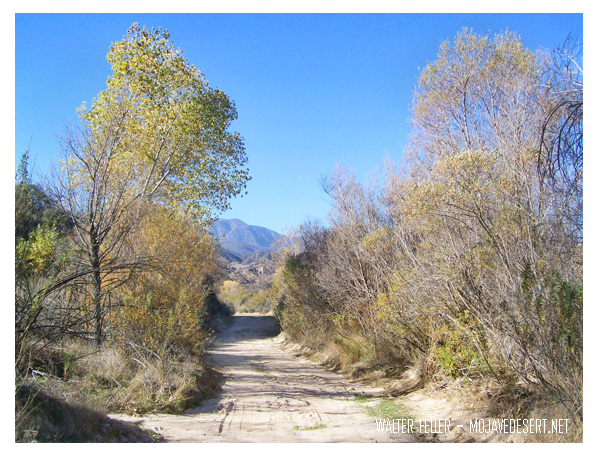Toll Road through the Cajon Pass
Brown's Turnpike and Van Dusen's Road

So while Sanford's road was definitely an improvement, the trip over the summit was still arduous for those hauling heavily loaded conveyances. The steep grade vexed the freighters for years, and it was not until 1861, with the increased trade to the mines and the need to transport heavy machinery to Holcomb Valley, that the impetus was provided to do something about the situation. The Los Angeles Star ran an article on April 6, 1861, proclaiming that it was essential to improve the road that was so vital to the economy of the Southland:
-
This road is the great thoroughfare from Los Angeles and San Bernardino to the great gold and silver fields now known to exist and which at present are being worked, east of the Sierra Nevada and Coast Range Mountains. And not only this, but over it all the travel from the north, not passing over the San Fernando Mountain, going southward, must pass. At the head of the caņon is one of the steepest mountains in the State, over which a road passes, and teamsters have always complained of the great difficulties encountered in the ascent.
So severely has this been felt, that many of them have offered $5 a load toll to any parties who would cut down the mountain and make a turnpike road of it. As the travel on this road has been greatly increased of late by the trade to the mines, it has become absolutely necessary to take steps to improve the mountain pass road. For this purpose subscription lists have been circulated this week here and in San Bernardino, to raise money to cut down the road across the mountain, and thus facilitate transit to the mines.
On April 20th, the Star reported that prospective subscribers for the Holcomb Valley road had appointed a committee consisting of prominent Cucamonga citizen John Rains, freighter W. T. B. Sanford and Los Angeles merchant Francis Mellus, who had examined the road and had returned with recommendations for alternative alignments. The cost was less than the $2,000 previously estimated, and it turned out the amount needed had already been collected. Elsewhere in the same issue of the Star, an article stated that Jed Van Dusen, the miner who later built the Holcomb Valley road, had been over the proposed route a second time, and he felt it was much better than he originally had supposed.
Meanwhile, on April 17th the state had passed legislation entitled, "An Act to Authorize the Construction of a Wagon Road in the Cajon Pass," which gave John Brown, Henry M. Willis and George L. Tucker the right to construct a road and to collect toll for its use at rates to be determined each year by the County Board of Supervisors. Work began immediately under a contract granted to Sydney P. Waite, Horace C. Rolfe and David N. Smith, who directed a crew of 30 to 40 workers. The job before them would not be easy, since the route went through some very difficult terrain.
The road began at Martin's Ranch near present-day Devore and traversed Cajon Canyon. Partway up the canyon, at what is now Blue Cut, was the narrowest segment of the lower portion of the road, known at that time as the "lower narrows." Continuing up the canyon along the bank of the creek, the road entered a ravine currently called Crowder Canyon, but known as Coyote Canyon in pioneer times.
This area, which was referred to as the "upper narrows," is extremely constricted in places, and is strewn with boulders, many of considerable size. The road followed the canyon bottom for a distance before turning up the steep ascent towards the summit. This was the section of road that caused the most trouble, both during the initial construction and subsequently with maintenance. By midsummer the construction was complete, and the Board of Supervisors established what seems to be a fairly stiff toll:
-
Man & Horse-------------------------------------.25
Wagon and one Span of Horses-----------1.00
Each additional Span---------------------------.25
Loose Stock Cattle or Horses per head----.05
Pack Animals-------------------------------------.25
Sheep ----------------------------------------------.03
Horse Cart or Buggy--------------------------- .50
The wagons left Los Angeles on the 17th of July and arrived at Holcomb Valley on August 13th. This had been the first major challenge for Brown and his road, and he had done everything in his power to assist Sanford in his efforts. The Los Angeles Star, reporting on their success, said, "All wagons from Los Angeles and San Bernardino now go by the turnpike -- the old Spanish trail, made into a good wagon road, having grass and water within easy distances."
< Previous - Next >